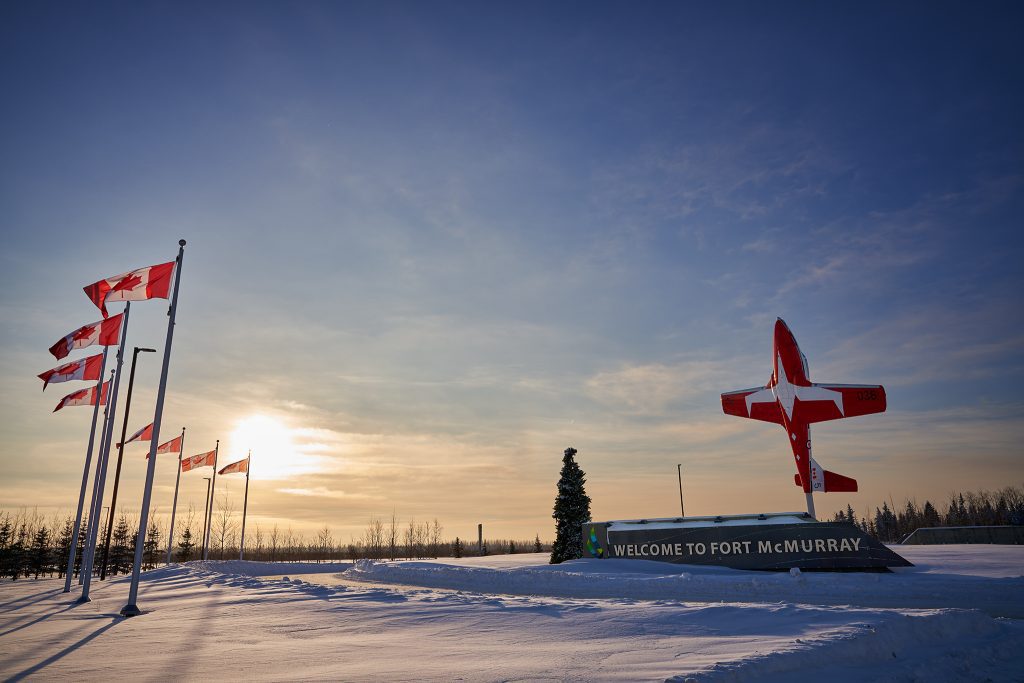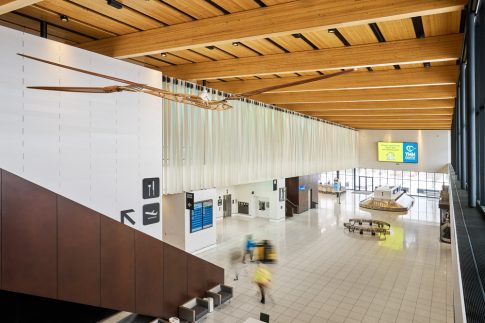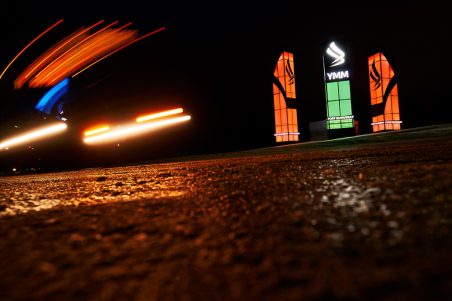The Fort McMurray Airport Terminal Building (FMAA) creates a relevant and meaningful portal for visitors and residents travelling to and from Fort McMurray Wood Buffalo. Geographically, the region has impressive natural beauty. When planning commenced on the terminal, the goal was set to showcase the beauty of the North throughout the building.
The $258 million terminal was designed by OMB (the office of mcfarlane biggar architects + designers inc.) and built by Ledcor. The elements and structures surrounding YMM have extraordinary stories to its design and create an aviation illustration unique to Fort McMurray Wood Buffalo and Western Canada. In 2013, the terminal was recognized in The Canadian Architect Awards of Excellence program,
The Terminal Design
OMB, 2014
Opening to great fanfare in June 2014, the new YMM airport terminal is a one-of-a-kind structure of long-span spaces, high windows and ceilings that allow natural daylight to stream in. The simple shifting of levels appeals to the eyes, helping orient passengers.
YMM’s unique look stems from the laminated pine wood beams used to support the roof, the largest wood-framed roof in North America. The exposed mass timber structure complements the other refined yet durable materials in the terminal’s exterior, including triple-glazed windows, terrazzo flooring and acoustic wood panels.
The material expression is derived from the incumbent palette of the industrial landscape: weathering steel, bitumen-coloured metal cladding and unfinished concrete. These tough materials are complemented with more sophisticated yet durable materials to further refine the interior spaces: unitized triple glazing, terrazzo flooring, acoustic wood panels and exposed mass timber structure.
YMM also has the largest application of Cross-Laminated Timber technology in Western Canada and was built with wood reclaimed from the devastating pine beetle epidemic in British Columbia.
For the full design scope, learn more on the Canadian Architect website.
Structure Location: 100 Snowbird Way
The YMM Welcome – Light Towers
F&D Scene Changes, 2014
The trident of three towers is located at the first entrance of the Fort McMurray International Airport inside the roundabout on Saline Creek Parkway. The towers range in height: one stands 18 feet, another 21 feet and the tallest at 25 feet. Constructed of steel and acrylic panels, each one features internal red, green, blue and white (RGWB) lighting with automotive-grade finishes. The light towers trident were designed, fabricated and installed by Calgary-based F&D Scene Changes Ltd.
Each tower displays an illuminated YMM logo and the Fort McMurray name. The primary artist of the logo design, Cameron Fam, integrated elements of aircraft design along with lighting inspired by the vibrant Aurora Borealis. “Visitors can enjoy the dynamic composition of three spire-shaped capsules that showcase the dancing light within,” said Fam. “The stylized tower bases evoke thoughts of aircraft engines and shock cones of jet-powered aircraft.”
Structure Location: Saline Creek Parkway
The Welcome Sign
F&D Scene Changes, 2014

On Snowbird Way, an iconic Canadian Forces Snowbirds aircraft is mounted over two nine-metre (30-foot) illuminated welcome signs, adding a unique depth of meaning to the signs welcoming visitors and serving as a landmark for the airport. The welcome signage was designed, fabricated and installed by Calgary-based F&D Scene Changes Ltd.
The aircraft is a Canadair CT-114 Tutor and painted in the colour used by the Canadian Forces (CF) Snowbirds 431 Air Demonstration Squadron. The Tutor was originally procured in the mid-60s to train student pilots. It was replaced in 2000 by the CT-156 Harvard II and CT-155 Hawk. Today, the Tutor is flown primarily by 431 Squadron’s Snowbirds.
Structure Location: Snowbird Way
Northern Lights Wall
OMB, 2014
The Northern Lights Wall forms a cornerstone of the thematic elements that animate the terminal. OMB (the office of mcfarlane biggar architects + designers inc.) drew its inspiration for the permanent installation from the northern lights and boreal forest.
Strategically positioned to enhance the experience of all passengers, whether arriving or departing, the Wall is the most predominant feature of the entry and arrivals hall.
Structure Location
Entry & Arrivals Hall


